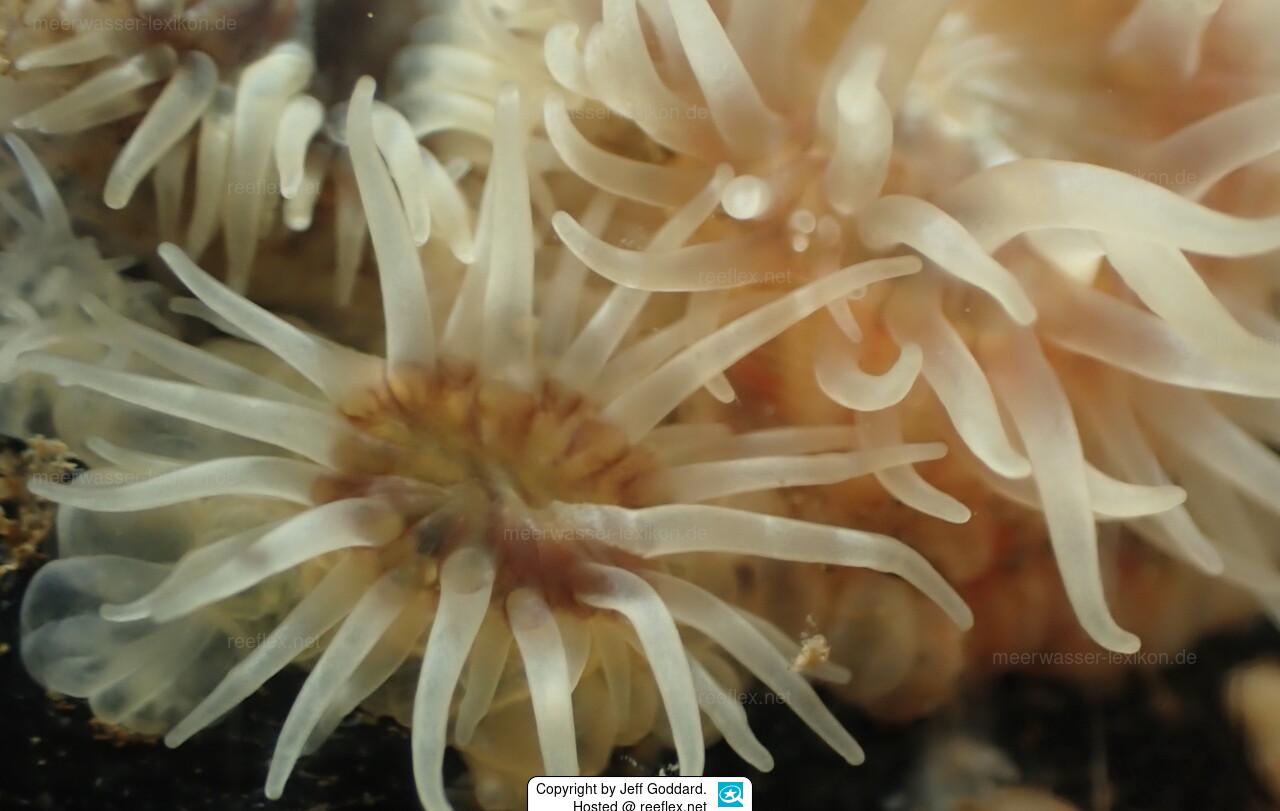Info
Anthopleura mariae sp. nov. is a new species of sea anemone from the rocky intertidal zone of Punta Morro, Baja California, and Punta Eugenia Baja California Sur, Mexico.
This species is characterized by a column of verrucae arranged in longitudinal rows from the margin to the limbus, with a red spot on each verruca, and by the presence of more than two siphonoglyphs and the absence of directional mesenteries.
The small anemone has between 48 and 96 tentacles; it is currently unknown if it additionally captures minute zooplankton.
The tentacles are 3-5 mm long and arranged in four to five cycles, they are conical, smooth, contractile, inner cycles slightly longer than the outer ones, beige or grayish purple, without markings
The anemone has an acylindrical column that is brownish, grayish or olive green.
The oral disc is flat and smooth, reaching 5 - 11 mm in diameter, it is brownish or grayish purple, with radial brown to beige markings extending from the tentacular bases to the mouth, the mouth is small and rounded.
The foot disc is well developed, 4-15 mm in diameter and slightly wider than the column, ranging in color from pale pink to beige.
Pale orange or beige acrorhagi are used for defense against enemies or competitors,
The anemone received its species name in honor of María S. Avalos, the mother of the first author.
Similar species: Anthopleura nigrescens
Literature reference:
Aurora Vassallo-Avalos, Ricardo González-Muñoz, Fabián H. Acuña, and Gerardo Rivas "Anthopleura mariae sp. nov. (Cnidaria: Actiniaria: Actiniidae), a New Species of Sea Anemone from the Mexican Pacific," Pacific Science 74(2), 159-170, (29 September 2020). https://doi.org/10.2984/74.2.5
This species is characterized by a column of verrucae arranged in longitudinal rows from the margin to the limbus, with a red spot on each verruca, and by the presence of more than two siphonoglyphs and the absence of directional mesenteries.
The small anemone has between 48 and 96 tentacles; it is currently unknown if it additionally captures minute zooplankton.
The tentacles are 3-5 mm long and arranged in four to five cycles, they are conical, smooth, contractile, inner cycles slightly longer than the outer ones, beige or grayish purple, without markings
The anemone has an acylindrical column that is brownish, grayish or olive green.
The oral disc is flat and smooth, reaching 5 - 11 mm in diameter, it is brownish or grayish purple, with radial brown to beige markings extending from the tentacular bases to the mouth, the mouth is small and rounded.
The foot disc is well developed, 4-15 mm in diameter and slightly wider than the column, ranging in color from pale pink to beige.
Pale orange or beige acrorhagi are used for defense against enemies or competitors,
The anemone received its species name in honor of María S. Avalos, the mother of the first author.
Similar species: Anthopleura nigrescens
Literature reference:
Aurora Vassallo-Avalos, Ricardo González-Muñoz, Fabián H. Acuña, and Gerardo Rivas "Anthopleura mariae sp. nov. (Cnidaria: Actiniaria: Actiniidae), a New Species of Sea Anemone from the Mexican Pacific," Pacific Science 74(2), 159-170, (29 September 2020). https://doi.org/10.2984/74.2.5







 Jeff Goddard, USA
Jeff Goddard, USA






















